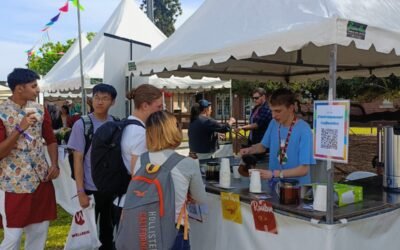
Safder Ahmed holding his book, ‘Still Alive.’ Credit: Safdar Ahmed
Have you ever wondered what it is like to be in one of Australia’s immigration detention centres? The recently published graphic novel ’Still Alive’ is the first of its kind to offer a glimpse into the daily experiences of refugees in detention centres.
Graphic journalism can be powerful in raising awareness of social and political issues as they are easy to consume yet often have a strong impact on its audience. The Walkley Awards winning artist and author of the graphic novel, Safdar Ahmed, explains that comics are a very subtle and sophisticated way of communicating, however they remain to be one of the most effective tools for activism. “Art can provide a context for understanding our place in the world, and using art to challenge power, to open our minds and to not just accept the way things are when they’re wrong and unjust,” said Mr Ahmed.
‘Still Alive’ is the culmination of almost a decade of visiting the Villawood Immigration Detention Centre and witnessing the lives of detained refugees and asylum seekers. Mr Ahmed has been visiting the centre since 2011, where he volunteered to run art workshops for people in detention, alongside other local artists. The workshops sparked the idea of facilitating a space for refugee artists, prompting the establishment of ‘The Refugee Arts Project’ that runs workshops, community dinners, and exhibitions for emerging artists.
The not-for-profit community arts organisation has successfully created a community of local and refugee artists who produced various forms of art from coffee painting, realistic drawings, resin artwork, music, poetry to zines. “The book is a natural outgrowth of community work with the Refugee Arts Project,” said Mr Ahmed.
The book illustrates various aspects of a refugee’s life in detention, including the struggle with food, sleep, relationships, education, spirituality and the lingering trauma from their survival journeys. “I wanted to put a spotlight on the way people resist detention and to show their agency, and I think resistance isn’t just about when people protest or when people riot or when people speak to the media. Resistance can occur every day in many other small ways,” notes Mr Ahmed.

Credit: Safder Ahmed
The author notes that most Australians are unaware of human rights violations that occur in immigration detentions. He adds that politicians have misled the public regarding the reality of the detention system for the past 30 years, and have succeeded in dehumanising and criminalising refugees who are often labelled as ‘que jumpers’, ‘illegal arrivals’ and ‘foreigners who will steal Australian jobs’. “The whole policy of mandatory detention is also an outgrowth and a continuation of Australia as a colonial project,” he said.
Despite efforts to raise awareness, the heart-breaking reality lingers that thousands of refugees continue to suffer from Australia’s immigration policies. Only one refugee mentioned in the book received an Australian citizenship, while the rest are left in limbo. “They don’t have family reunion, they’re still alone, they’re still in a very difficult legal situation which is isolating and punishing,” he notes.
According to the Department of Home Affairs, around 1,484 people are locked up in detention centres, and more than 500 reside in the community with no visa and minimal rights. This is in addition to 30,000 asylum seekers and refugees whose claims have not been finalised as mentioned in the 2019 Australian Human Rights report.
Mr Ahmed encourages his readers to hear directly from refugees who shared their stories like Behrouz Boochani. He adds that being more active in the politics of this nation is equally important. “People can protest, people can write letters to their local politicians, people can join associations that support refugees and asylum seekers directly… send a clear message that Australia’s position is unacceptable and immoral,” he said.

Credit: Shayma Abdellatif
You can purchase ‘Still Alive’ from the Twelve Panels Press website.



